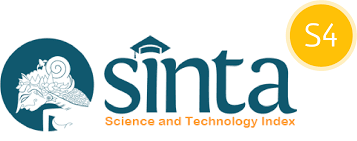Image Tracking Berbasis AR Untuk Peningkatan Pembelajaran Buah Pada Pendidikan Anak Usia Dini (PAUD)
DOI:
https://doi.org/10.29408/jit.v6i2.16830Keywords:
Augmented Reality, Fruits, MDLC, PAUDAbstract
The current recognition and learning system still uses magazines, books and websites. This makes the lessons of the topics taught still difficult to understand. In this study, a fruit recognition learning model was created in early childhood education based on Augmented Reality and digitalized teaching aids. Augmented Reality is a technology that embodies the merging of the real world (reality) and virtual world (virtual) where this technology is also known as Virtual Reality. The marker in the form of an image will be captured by the camera, processed and a 3D fruit animation will appear on the mobile screen. The purpose of this research is to produce a fruit recognition learning model in PAUD TK Aba Sukoharjo Kalasan based on Augmented Reality and to create digitalized teaching aids. By using Augmented Reality the application can be educational and attract interest in children's curiosity. The method used in this study is the Multimedia Development Life Cycle (MDLC). The fruit recognition application has been applied to several child respondents. Based on research trials, before there was an application for interest in learning, children learned fruit recognition with a score of 73% with the predicate agreeing. The effect of positive trends on children to learn with augmented reality learning media is shown by a score of 81% of 30 child respondents stating that the application is very effective as an increase in the recognition of fruitsReferences
M. Agil, S. Lina, and M. Sitio, “Implementasi Metode Markerless Augmented Reality Untuk Edukasi Nama Buah-Buahan Berbasis Android,” vol. 14, no. 2, pp. 105–115, 2022.
K. Nistrina, “Penerapan Augmented Reality dalam Media Pembelajaran,” J. Sist. Informasi, J-SIKA, vol. 03, no. 01, pp. 1–6, 2021.
P. Haryani and J. Triyono, “Augmented Reality (Ar) Sebagai Teknologi Interaktif Dalam Pengenalan Benda Cagar Budaya Kepada Masyarakat,” Simetris J. Tek. Mesin, Elektro dan Ilmu Komput., vol. 8, no. 2, p. 807, 2017, doi: 10.24176/simet.v8i2.1614.
W. H. dan E. W. Eka Ardhianto, “Augmented Reality Objek 3 Dimensi dengan Perangkat Artoolkit dan Blender,” Din. Teknol. …, vol. 17, no. 2, pp. 107–117, 2012, [Online]. Available: http://www.unisbank.ac.id/ojs/index.php/fti1/article/view/1658
S. R. Talango, “Konsep Perkembangan Anak Usia Dini,” Early Child. Islam. Educ. J., vol. 1, no. 1, pp. 92–105, 2020, doi: 10.54045/ecie.v1i1.35.
A. Munar and Suyadi, “Penggunaan Media Animasi dalam Peningkatan Kemampuan Menyimak Anak Usia Dini,” Kindergarten J. Islam. Early Child. Educ., vol. 4, no. 2, pp. 155–164, 2021, [Online]. Available: http://dx.doi.org/10.24014/kjiece.v4i2.13207
M. F. Fathonah, S. Wahyuningsih, and M. M. Syamsuddin, “Efektivitas Media Audio Visual Terhadap Kecerdasan Visual Spasial Anak Usia 5-6 Tahun,” Kumara Cendekia, vol. 8, no. 2, p. 142, 2020, doi: 10.20961/kc.v8i2.39789.
A. F. Dewi and M. Ikbal, “Perancangan Augmented Reality (AR) Sebagai Media Promosi Objek Wisata Berbasis Android,” Infotek J. Inform. dan Teknol., vol. 5, no. 1, pp. 179–186, 2022, doi: 10.29408/jit.v5i1.4760.
E. S. Usin, “Pengembangan Aplikasi AR BUAH Sebagai Penerapan Edukasi Interaktif Menggunakan Metode Menerapkan Augmented Reality (AR),” Researchgate.Net, no. November, pp. 0–9, 2021,
Y. Ikhwani and M. R. Raharjo, “Implementasi Augmented Reality Untuk Media Informasi Buah Langka Khas Kalimantan Selatan,” Technol. J. Ilm., vol. 11, no. 4, p. 187, 2020, doi: 10.31602/tji.v11i4.3637.
H. F. Salma, A. Komarudin, and R. Yuniarti, “Game Edukasi Pengenalan Buah-Buahan Berbasis Augmented Reality(AR) Menggunakan Multimedia Develpoment Life Cycle (MDLC),” Semin. Nas. Inform. dan Apl. 2021, no. Mdlc, pp. 37–40, 2021, [Online]. Available: https://snia.unjani.ac.id/web/index.php/snia/article/view/324
H. Bahtiar, M. Djamaluddin, and M. R. Sufriadi, “Pengenalan Arsitektur Rumah Tradisional Desa Belek Sembalun Lawang Lombok Dengan Menggunkan Animasi 3d Menggunakan Blender Sebagai Media Pembelajaran,” Infotek J. Inform. dan Teknol., vol. 3, no. 1, pp. 71–78, 2020.
L. A. Wardana, “Perancangan Antarmuka Aplikasi Mobile Konseling Pada Gereja Katolik dengan Metode User Centered Design dan Wireframe,” S2 Thesis, pp. 17–39, 2016, [Online]. Available: http://eprints.stainkudus.ac.id/192/5/5. BAB II.pdf
A. Arifudin, D. Kuswandi, and Y. Soepriyanto, “Pengembangan Media Obyek 3 Dimensi Digital Sel Hewan dan Tumbuhan Memanfaatkan Piramida hologram Untuk MTS,” Kaji. Teknol. Pendidik., vol. 2, no. 1, pp. 9–15, 2019.
B. Kurniawan and M. Romzi, “Perancangan Uiux Aplikasi Manajemen Penelitian Dan Pengabdian Kepada Masyarakat Menggunakan Aplikasi Figma,” J. Sist. Inf. Mahakarya, vol. 05, no. 1, pp. 1–7, 2022
Downloads
Published
How to Cite
Issue
Section
License
Semua tulisan pada jurnal ini menjadi tanggung jawab penuh penulis. Jurnal Infotek memberikan akses terbuka terhadap siapapun agar informasi dan temuan pada artikel tersebut bermanfaat bagi semua orang. Jurnal Infotek ini dapat diakses dan diunduh secara gratis, tanpa dipungut biaya sesuai dengan lisense creative commons yang digunakan.
Jurnal Infotek is licensed under a Creative Commons Attribution 4.0 International License.
Statistik Pengunjung




